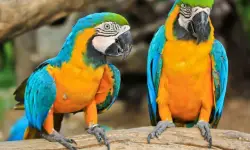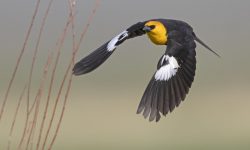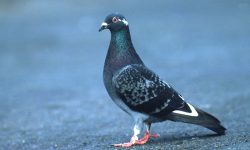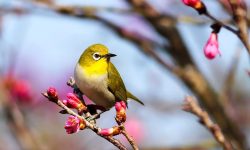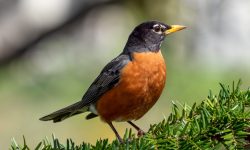Cormorants are often seen perched on rocks, wings spread wide, overlooking rivers, lakes, and coastlines across North America. These dark-feathered waterbirds are not only a striking part of the landscape—they are remarkable underwater hunters. With sleek bodies, sharp beaks, and specialized diving skills, cormorants have earned their title as the fishers of American waters.
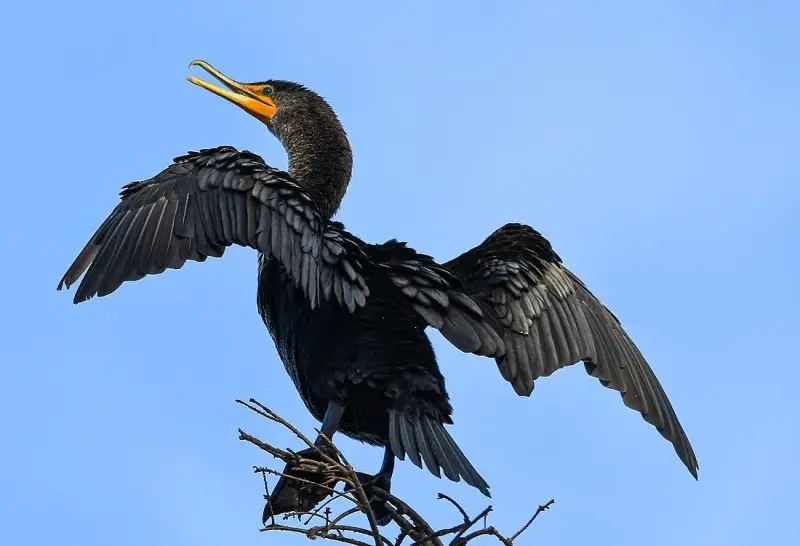
Meet the Double-crested Cormorant
North America’s Most Familiar Fishing Bird
Glide across a lake in the early morning, or scan the rocks along a coastal harbor, and you’re likely to spot a sleek, black waterbird with a piercing orange throat and a sharp, hooked beak—the unmistakable Double-crested Cormorant (Nannopterum auritum).
This is the most widespread cormorant in the United States, thriving in an incredible variety of habitats—from the vast Great Lakes to the quiet shallows of inland ponds, and from remote rivers to the bustling piers of seaside cities. Whether in freshwater or saltwater, this bird is right at home wherever fish are plentiful.
During the breeding season, the species earns its name from the two wispy crests of feathers that sprout from each side of its head—like wild eyebrows of a bird with attitude. Its body is cloaked in dark, almost reptilian feathers, and its long neck and hooked bill give it a slightly prehistoric silhouette.
At a glance, some mistake it for a duck or even a goose. But once you see it dive, twist, and emerge with a fish in its beak, you know you’re watching one of America’s true underwater hunting specialists.
Fish-Catching Experts of the Water
Built for Speed and Precision
The cormorant is no ordinary waterbird—it’s a sleek, underwater predator, built from head to tail for one thing: catching fish with remarkable skill and speed.
While ducks dabble on the surface and herons strike from above, cormorants plunge headfirst into the water and chase their prey below. Once submerged, they become torpedoes with feathers—driving themselves forward with powerful strokes of their webbed feet and steering with agile tails and necks. Their bodies are long, narrow, and smooth, slicing effortlessly through currents in pursuit of prey.
Spotting a fish, the cormorant launches forward in a lightning-fast lunge, clamping down with its sharp, hook-tipped beak. The curve of the bill acts like a grappling hook, gripping the fish tightly to prevent escape—even when the prey is slick and squirming.
Most of their catches fall in the 3- to 15-inch range, but don’t underestimate them—cormorants are more than capable of wrestling down larger fish when the opportunity strikes. They’re not picky eaters, either. From perch and bass to catfish and shad, they go after whatever’s abundant and easy to catch in the waters they hunt.
Underwater Vision and Tactics
What makes the cormorant truly dangerous to fish isn’t just its speed—it’s its precision, powered by extraordinary vision. Unlike many birds, cormorants can see clearly both in the air and underwater. Their eyes adjust rapidly to changes in light and depth, allowing them to spot fish even in murky or turbulent waters—where most predators would struggle to see anything at all.
But they don’t just dive and hope. These birds are tactical hunters. Observers have seen cormorants herding fish into shallows or pinning them against submerged structures before striking. In some regions, they even team up in groups, driving schools of fish into tighter formations to make the catch easier for everyone.
It’s a level of strategy rarely seen in birds, and it gives cormorants a powerful edge. In the underwater world, they are swift, smart, and stunningly effective hunters—proof that the best fishers don’t always need a line and hook.
Feeding Behavior and Diet
How Much Fish Does a Cormorant Eat?
With the heart of a hunter and the stomach of an athlete, the Double-crested Cormorant is a bird that doesn’t just snack—it devours. An adult cormorant consumes between one and two pounds of fish each day, depending on water temperature, prey availability, and breeding demands.
During the breeding season, when parents are responsible for feeding not only themselves but their ever-hungry chicks, that number climbs dramatically. Cormorants may hunt from sunrise to sunset, making countless dives to satisfy the appetites in their nests.
And their feeding isn’t lazy. These birds work for their meals—diving dozens of times a day, staying submerged for up to a minute each time, and chasing prey through water with incredible agility. Unlike pelicans that gulp down fish whole above the surface, cormorants often swallow their catch underwater or immediately upon surfacing. Sometimes they can be seen tossing the fish into the air, struggling to flip it head-first—the safest way to avoid getting spiked by sharp fins during swallowing.
Opportunistic and Adaptive Feeders
Cormorants are the ultimate opportunists when it comes to food. While they favor small to medium-sized fish, they aren’t picky. Instead of targeting a specific species, they simply go after what’s most abundant and easiest to catch in a given environment.
In freshwater lakes and rivers, their menu often includes yellow perch, sunfish, crappie, and minnows. In coastal areas, they might dine on anchovies, herring, smelt, flounder, or even small squid. If fish are scarce, they’ve also been known to eat amphibians and crustaceans.
This dietary flexibility is part of what makes them so widespread and successful across North America. However, it’s also what brings them into conflict with humans—especially commercial fishers and aquaculture operations. When cormorants move in and consume large quantities of farmed or sport fish, they’re often seen as competitors rather than natural predators.
Still, in wild ecosystems, cormorants play a valuable role in maintaining ecological balance, often targeting slower, injured, or overpopulated fish species. Their feeding habits reflect a blend of instinct, efficiency, and environmental awareness—a finely tuned survival system that has stood the test of time.
Cormorants in American Ecosystems
Natural Balancers in Aquatic Habitats
Beneath their sleek, shadowy presence, cormorants perform a vital ecological service in lakes, rivers, and coastal waters across America. As top aquatic predators, they act as natural population managers, often preying on the weaker, slower, or most abundant fish in a given environment.
By doing so, cormorants help to prevent overpopulation of certain fish species, reduce competition for resources, and maintain a healthy mix of species in aquatic ecosystems. This type of selective predation allows stronger fish to thrive and supports greater biodiversity, making cormorants crucial players in aquatic food web stability.
Despite their ecological value, these birds have occasionally been cast in a negative light—particularly in areas where sport fishing or aquaculture is economically important. However, numerous scientific studies have shown that in natural, unmanaged waters, cormorants rarely pose a long-term threat to fish populations. In fact, their presence often signals a healthy, functioning ecosystem.
Instead of harming their environment, cormorants often strengthen it, playing the same keystone role that wolves do in forests or sharks in coral reefs.
Nesting Colonies Near Water
Cormorants are communal by nature, and when breeding season arrives, they gather in dense nesting colonies near the water’s edge—on isolated islands, rocky cliffs, or high in trees overlooking lakes and estuaries. These locations offer proximity to rich fishing grounds, making it easier for parents to deliver fresh catches to their chicks throughout the day.
A cormorant nesting site is a vivid scene: noisy, crowded, and unmistakably fishy. The ground is often littered with bones, feathers, and the remnants of half-digested meals, a gritty testament to the colony’s relentless appetite.
These nesting areas, while biologically important, can sometimes alter local vegetation due to accumulated guano, which is rich in nitrogen. Still, many such colonies persist for generations, supporting thousands of birds and contributing to the broader health of the region’s wetlands and aquatic habitats.
In every environment they inhabit, from remote forested lakes to urban coastal piers, cormorants leave their mark—not just as master fishers, but as essential stewards of the underwater world.
Human Interactions and Controversy
Conflicts with Fisheries and Fish Farms
The cormorant’s success as a hunter has made it both admired and resented. In the eyes of birdwatchers and ecologists, it’s a marvel of evolution. But in the eyes of many fishers and aquaculture operators, it’s a competitor—and sometimes, a problem.
Because cormorants consume significant amounts of fish daily, their presence near commercial fisheries, hatcheries, and sport-fishing lakes often raises concern. In some areas, anglers and fish farmers report declining fish stocks, pointing to large nesting colonies of cormorants as a major factor. Images of these birds diving and surfacing with fish in their beaks can evoke frustration—especially when they appear near economically valuable species.
This tension has sparked heated debates over population control. In response to public pressure, some U.S. states have implemented regulated culling programs, allowing limited numbers of cormorants to be removed to protect fish farms or restore balance to overexploited waters. However, these efforts remain controversial, with conservationists warning of unintended ecological consequences.
Scientific studies increasingly suggest that the real culprits behind fish population declines are not the birds—but humans themselves. Overfishing, habitat destruction, pollution, and invasive species often do far more damage to aquatic ecosystems than natural predators like cormorants. In many cases, blaming the bird oversimplifies a much more complex environmental problem.
Cultural and Traditional Use
Despite modern conflicts, cormorants have also played a respected and even honored role in human history. In certain regions of China and Japan, fishermen have long practiced a traditional technique known as cormorant fishing. By placing a loose ring around the bird’s neck and guiding it from a small boat, the fisher allows the bird to dive, catch fish, and bring them back to the handler.
This practice is more than a spectacle—it’s a testament to the bird’s natural hunting skill and the deep relationship between humans and wildlife. Though largely ceremonial today, cormorant fishing remains a cultural treasure, passed down through generations and celebrated in festivals.
Whether as ally or adversary, the cormorant continues to capture human attention—and challenge us to consider how we share our waters with one of nature’s most efficient predators.
Conservation and Protection Status
A Comeback After Decline
Cormorants were once heavily impacted by pesticide use, especially DDT, which weakened eggshells and caused population crashes in the mid-20th century. Since the banning of DDT and implementation of environmental protections, cormorant populations have rebounded, especially in the U.S. and Canada.
The Double-crested Cormorant is currently listed as a species of Least Concern by the IUCN, but is still monitored closely due to ongoing conflicts with human interests.
Conclusion: Masters of the Water
Cormorants are more than just silhouettes on the shoreline—they are expert hunters, uniquely adapted for life beneath the surface. With keen eyes, powerful dives, and clever tactics, they have earned their place as the true fishers of American waters.
Whether gliding across a lake at dawn or plunging beneath the waves after prey, the cormorant is a stunning example of how form meets function in the wild. Their story is one of resilience, adaptation, and the constant motion of life where water meets sky.

